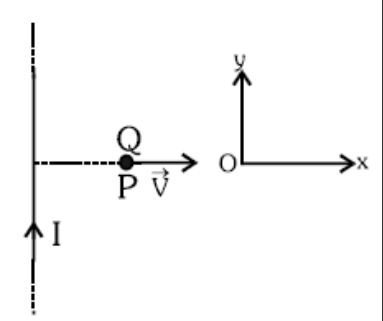When a magnetic compass needle is carried nearby to a straight wire carrying current, then
I. the straight wire cause a noticeable deflection in the compass needle.
II. the alignment of the needle is tangential to an imaginary circle with straight wire as its centre and has a plane perpendicular to the wire
(I) is correct
(II) is correct
both (I) and (II) are correct
neither (I) nor (II) is correct
The correct Answer is:C
To solve the question regarding the behavior of a magnetic compass needle near a straight wire carrying current, we will analyze the two statements provided.
1. Understanding the Magnetic Field Around a Current-Carrying Wire:
- A straight wire carrying an electric current generates a magnetic field around it. The direction of this magnetic field can be determined using the right-hand rule. If you point your thumb in the direction of the current, your fingers will curl in the direction of the magnetic field lines.
Hint: Remember the right-hand rule to visualize the direction of the magnetic field.
2. Effect on the Compass Needle:
- When a magnetic compass needle is brought near the wire, it will align itself with the magnetic field produced by the wire. Since the magnetic field is present, the compass needle will experience a torque and will deflect from its original position.
Hint: Think about how a compass needle aligns with magnetic fields, similar to how it aligns with the Earth's magnetic field.
3. Deflection of the Compass Needle:
- The deflection of the compass needle is noticeable because the magnetic field strength around the wire is significant enough to overcome the needle's own magnetic moment. The needle will come to rest in a position where it aligns with the magnetic field lines created by the wire.
Hint: Consider the balance of forces acting on the compass needle when it is near the wire.
4. Alignment with Magnetic Field Lines:
- The compass needle will align itself tangentially to the circular magnetic field lines around the wire. This means that at any point around the wire, the needle will point in the direction that is tangent to the imaginary circle formed by the magnetic field lines.
Hint: Visualize the circular pattern of the magnetic field lines around the wire to understand the tangential alignment of the needle.
5. Conclusion:
- Both statements provided in the question are true. The straight wire does cause a noticeable deflection in the compass needle, and the needle aligns tangentially to the circular magnetic field lines around the wire.
Hint: Review the definitions of magnetic fields and compass behavior to reinforce your understanding.
Final Answer:
Both statements I and II are true. Therefore, the correct option is C.
- A straight wire carrying an electric current generates a magnetic field around it. The direction of this magnetic field can be determined using the right-hand rule. If you point your thumb in the direction of the current, your fingers will curl in the direction of the magnetic field lines.
- When a magnetic compass needle is brought near the wire, it will align itself with the magnetic field produced by the wire. Since the magnetic field is present, the compass needle will experience a torque and will deflect from its original position.
- The deflection of the compass needle is noticeable because the magnetic field strength around the wire is significant enough to overcome the needle's own magnetic moment. The needle will come to rest in a position where it aligns with the magnetic field lines created by the wire.
- The compass needle will align itself tangentially to the circular magnetic field lines around the wire. This means that at any point around the wire, the needle will point in the direction that is tangent to the imaginary circle formed by the magnetic field lines.
- Both statements provided in the question are true. The straight wire does cause a noticeable deflection in the compass needle, and the needle aligns tangentially to the circular magnetic field lines around the wire.
Both statements I and II are true. Therefore, the correct option is C.
Topper's Solved these Questions
- MOVING CHARGES AND MAGNETISM BOOK - NCERT FINGERTPS ENGLISHCHAPTER - MOVING CHARGES AND MAGNETISM EXERCISE - HOTS
5 Videos
- MOVING CHARGES AND MAGNETISM BOOK - NCERT FINGERTPS ENGLISHCHAPTER - MOVING CHARGES AND MAGNETISM EXERCISE - EXEMPLAR PROBLEMS
6 Videos
- MAGNETISM AND MATTER BOOK - NCERT FINGERTPS ENGLISHCHAPTER - MAGNETISM AND MATTER EXERCISE - NCERT Exemplar
5 Videos
- NUCLEIBOOK - NCERT FINGERTPS ENGLISHCHAPTER - NUCLEIEXERCISE - Assertion And Reason
15 Videos
Similar Questions
Knowledge Check
If a long straight wire carries a current of 40 A, then the magnitude of the field B at a point 15 cm away from the wire is
A5.34×10−5TB8.34×10−5TC9.6×10−5TD10.2×10−5T
A magnetic pole of strength 4 Am is moved twice around a long straight wire carrying a current of 3A. The work done is
View Solutiona very long straight wire carries a current I. at the instant when are charge -Q at point P has velocity v as shown in figure the force on the charge is

View SolutionA long straight wire carries a current of 35A. What is the magnitude of the field →B at a point 20cm from the wire?
View SolutionA long, straight wire carries a current along the z-axis. One can find two points in the x-y plane such that
View SolutionA very long straight wire carries a current I. At the instant when a charge +Q at point P has velocity→V, as shown, the force on the charge is-

View SolutionA very long straight wire carries a current I. At the instant when a charge +Q at point P has velocity →V, as shown, the force on the charge is

View SolutionThe magnetic field strength at a point P distant r due to an infinite straight wire carrying a current i is as shown in the figure

View Solution

